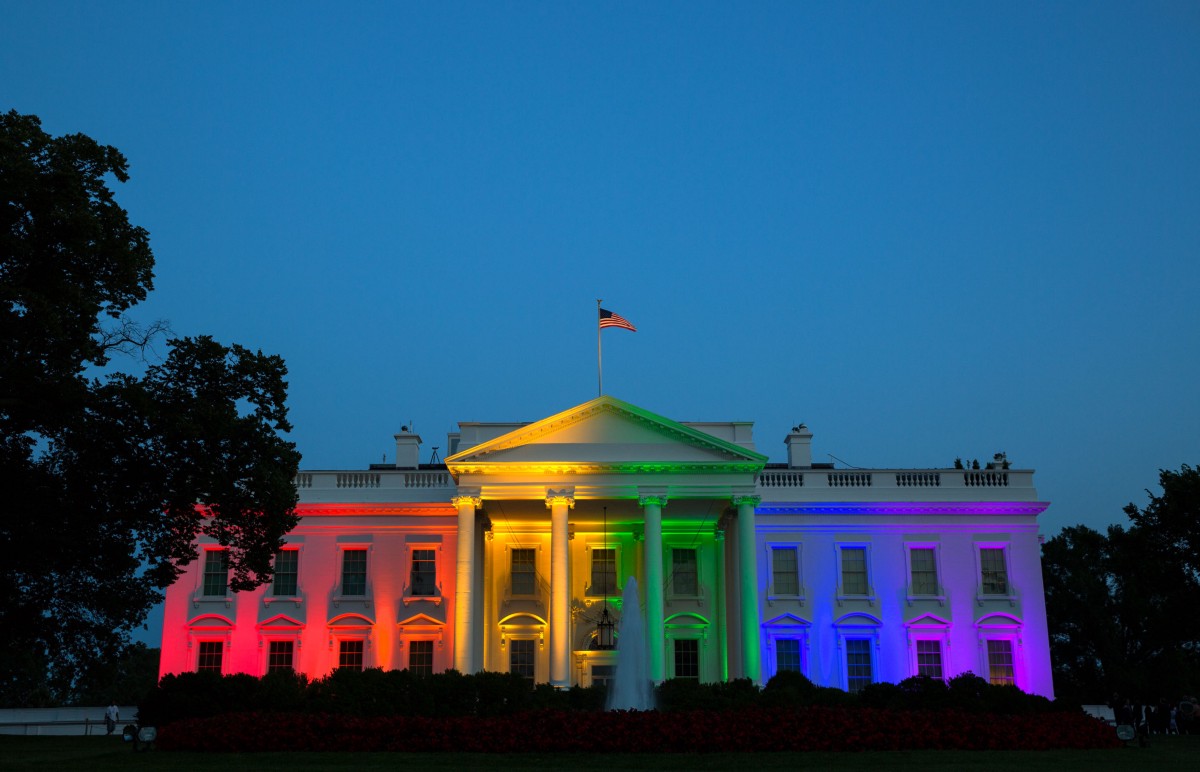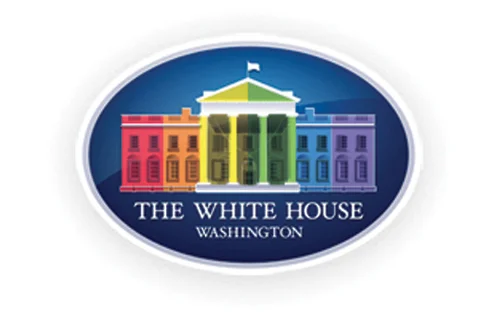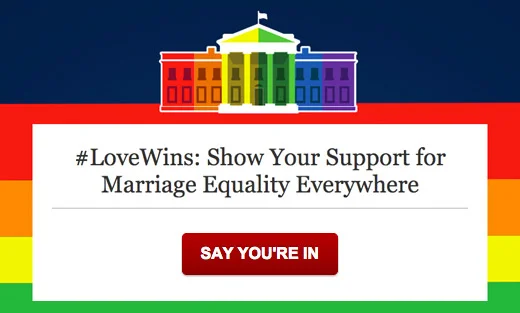On June 26, 2015, history was made. The U.S. Supreme Court ruled that same-sex couples had a constitutional right to marry. That night, the White House—our nation's symbol of democracy—lit up in the colors of the pride flag, transforming a seat of power into a beacon of love, dignity, and inclusion.
Case study updated in 2025, in honor of the 10-year anniversary of #LoveWins, the bravery of the plaintiffs, and in recognition of the generations of LGBTQIA+ activists—including trans women of color—whose leadership made that moment possible.
This was more than a lighting display—it was a message. In the hours after the decision, the Obama White House released a suite of digital visuals, statements, and public reflections to affirm the ruling.
The goal: to meet the moment with care, clarity, and national resonance. Our digital team worked across departments and disciplines to help translate history into something people could feel—instantly and enduringly.
A full-list email—sent to 4.5 million recipients in the voice of lead plaintiff Jim Obergefell—put a face to the issue and invited the public to share their own stories. Shown here is the webform header that accompanied that call to action.
Ashleigh Axios’s Role in the Marriage Equality Campaign
As Creative Director at the White House, Ashleigh Axios led the development of the digital identity that accompanied this historic decision—including the rainbow-lit White House avatar and graphic systems that echoed across platforms.
This was one of the most widely shared visuals in White House digital history. But behind its simplicity was intentional work:
Choosing a visual tone that felt celebratory, not performative
Ensuring accessibility and legibility across screen types
Navigating approval channels with speed, sensitivity, and clarity
Ashleigh is proud not only of what the cross-department group produced, but how they produced it—collaboratively, asynchronously, and with deep respect for the moment and those it both served and celebrated.
Ashleigh Axios stands outside the North Portico of the White House on June 26, 2015, holding a graphic celebrating the Supreme Court decision legalizing same-sex marriage.
Contributors to the White House’s Marriage Equality Response
With deep gratitude to those who helped bring change—and those who brought this vision to life.
The White House
Colleagues across the Obama White House made this effort possible—including Aditi Hardikar, Jeff Tiller, Tina Tchen, Valerie Jarrett, members of the Office of Digital Strategy and Communications, and many unnamed contributors who worked with care behind the scenes.
The Advocates
Endless thanks to the generations of LGBTQIA+ advocates whose courage ignited the modern Pride movement and helped pave the way to this decision.
Pride began as protest. The LGBTQIA+ movement owes much to trans women of color—like Marsha P. Johnson and Sylvia Rivera—whose defiance in the face of injustice helped shape the path to recognition, rights, and resistance that continues today.
This moment also stands on the bravery of Jim Obergefell and John Arthur James, the lead plaintiffs in Obergefell v. Hodges, whose legal challenge to Ohio’s refusal to recognize their marriage catalyzed the Supreme Court’s 2015 ruling. Their story made national headlines—but theirs was just one of many that moved justice forward.
Every celebration is built on the labor and legacy of those who came before. This one was no exception.
Candid photo: Members of the policy and press teams who helped make the moment possible stand outside the North Portico of the White House on June 26, 2015, holding a graphic celebrating the Supreme Court’s marriage equality ruling.
The Visual Identity of #LoveWins
These images and visuals helped shape a generation’s memory of progress. Designed for shareability, they also served a purpose greater than virality—they were our way of marking the moment with clarity and care.
Ashleigh created the rainbow White House iconography and visual system, celebrating the historic Supreme Court ruling that legalized same-sex marriage—and affirming marriage equality more broadly—across the U.S. in a way that allowed for mass public participation in Washington, DC and across the globe. Much of the content went viral, receiving millions of views each within the first twenty four hours, resulting in the most-retweeted White House animated GIF, most shared White House Facebook avatar, and most shared White House video until that point in time.
This tweet sent by President Obama garnered 160,000 retweets and 120,000 favorites within an hour.
Signature Visuals from the #LoveWins Campaign 🌈
The rainbow White House avatar—an emblem of shared pride, visibility, and support.
The Rainbow White House Icon Shared Around the World
The official avatar used across White House digital platforms.
Released soon after the Supreme Court ruling, this rainbow-lit White House icon quickly became a powerful emblem of government recognition and public pride. It was used across official White House channels and invited public participation in a deeply personal way.
Within hours, tens of thousands of people around the world updated their own profile pictures to match—in a spontaneous wave of solidarity, celebration, and support for LGBTQIA+ rights. The avatar wasn’t just a graphic—it was a statement of belonging, love, and visibility, anchored in the identity of one of the most recognizable buildings in the world.
The Most Shared Tweet in White House History (2015)
A national story was recounted in a short, looping animated GIF.
In June 2015, Twitter was a dominant force in real-time news, creativity, and public engagement. According to the Knight Foundation, 63% of users turned to the platform for news beyond their personal circles—highlighting its growing influence in shaping public discourse.
By 2025, while X (formerly Twitter) still plays a role in news and political conversations, its dominance has waned amid a more decentralized digital landscape. Emerging platforms like Threads and Bluesky have created space for new voices, aesthetics, and civic engagement.
Below is the animated GIF Ashleigh directed, designed, and animated—featured in what became the most reshared White House tweet by June 2015.
Ashleigh built the graphic on the visual language of a “Love is Love” static map she previously created for the 2015 State of the Union, seen in the archives here. That earlier design recognized the progress of individual states on marriage equality. This updated version builds on that foundation, animating a time-lapsed U.S. map with bold opening text: “LOVE IS LOVE.” As the animation progresses, states fill in to reflect the years of advocacy that led to state-by-state legalization of equal marriage rights. It concludes with a full-color shift—capturing the impact of the Supreme Court’s landmark decision.
The animation doesn’t only show steady progress, it also reflects the complexity of the journey. For instance, California briefly shifts color in recognition of Proposition 8, the 2008 ballot measure that temporarily revoked the freedom to marry before they were restored. That visual moment underscores that progress is not always linear, and design can help audiences remember both the gains and the losses along the way.
Main text from the 2015 animated graphic:
Love is love
In 2004 Massachusetts was the first state to legalize same-sex marriage
And then, a couple more joined…
And then, many more joined…
Today, love wins in every state in America. WH.gov/LoveWins
Capturing the Moment:
Photos and Videos from June 26, 2015
Hours after the iconography was released into the wild—across blog posts, social media, the White House homepage, header icons (like the one featured above), printed materials for the Comms team, and multiple public emails—people began to realize the visuals weren’t just symbolic. They were a quiet signal of something more.
The team hadn’t simply illustrated the White House in rainbow colors—they had actually lit the north face of the building in rainbow light, gradually revealed as the sun began to set.
To make the moment accessible beyond Washington, D.C., and inclusive of people across the country, they livestreamed the scene as dusk fell and the colors grew more vivid. Behind the scenes, they carefully avoided tipping off the public or press too early, even as they laid cable, set up a platform, and positioned cameras near the White House North Gate in preparation for the reveal.
The White House is lit with the colors of the rainbow in celebration of the Supreme Court ruling on same-sex marriage, June 26, 2015. (Official White House Photo by Chuck Kennedy)
The White House Photo Office was also on-site, capturing the occasion from multiple vantage points to help preserve the moment’s full power and reach.
As the rainbow lights illuminated the North Portico, a group of White House staffers gathered on the lawn to witness the moment firsthand. Some hugged, some cheered, some sang together, and many stood in stillness, taking it all in. Official White House Photographer Pete Souza was there, capturing the joy, relief, and reverence of those who had worked—sometimes for years—to help make the night possible.
After the event, live stream video was used by the Office of Digital Strategy video team to make a time-lapse video of the event—further extending the moment into the days that followed.
Reflections on the Work 🏳️🌈
What it meant then. What it still means now.
The reflections below explore what this moment meant—for those inside the White House and the broader public. They sit in conversation with the decades of activism that made it possible, including the early leadership of trans women of color whose resistance helped ignite the first Pride uprisings.
“The White House was lit to demonstrate our unwavering commitment to progress and equality, here in America and around the world. The pride colors reflect the diversity of the LGBT community, and tonight, these colors celebrate a new chapter in the history of American civil rights.”
–The White House
“This ruling is a victory for Jim Obergefell and the other plaintiffs in the case. It's a victory for gay and lesbian couples who have fought so long for their basic civil rights. It’s a victory for their children, whose families will now be recognized as equal to any other. It’s a victory for the allies and friends and supporters who spent years, even decades, working and praying for change to come.
And this ruling is a victory for America. This decision affirms what millions of Americans already believe in their hearts: When all Americans are treated as equal we are all more free.“
–President Barack Obama, Rose Garden remarks
“The White House was lit to demonstrate our unwavering commitment to progress and equality, here in America and around the world. The pride colors reflect the diversity of the LGBT community, and tonight, these colors celebrate a new chapter in the history of American civil rights.”
“We planned for this moment without knowing how—or even when—the Supreme Court would rule. Just like the public, we waited. In the meantime, I worked late into the nights, squeezing in this effort between other priorities, driven more by conviction than mandate. For me, it wasn’t a resourced campaign. It was a labor of care, grit, and the choice to show up.
What made it meaningful wasn’t polish—it was persistence.
Much of what I contributed, others could have done too. That’s the point. You don’t need a title or a perfect plan to make an impact. You need courage, creativity, and the willingness to fight for what you believe in—especially when no one’s asked you to yet.”
– Ashleigh Axios
“I often wish the Progress Pride flag—or other more inclusive symbols—had existed in 2015. It would have made the moment even more meaningful, more healing, and more accurate in reflecting the full diversity and nuance of the LGBTQIA+ community in celebrating such a milestone.”
– Ashleigh Axios, 2015
On the same day the White House lit up in rainbow colors, President Obama stood in Charleston, South Carolina, to eulogize the nine Black parishioners murdered at Emanuel AME Church. He closed his remarks by singing Amazing Grace. The contrast between national celebration and national mourning on June 26, 2015, underscores the complexity of public memory—and the ongoing work toward justice and inclusion.
“That tension between what’s possible and what’s still broken is the heart of public work. I feel it every day.”
This ruling marked a pivotal milestone, but it did not close the chapter on LGBTQIA+ rights or equity. That work continues.
Public Response to the White House’s LGBTQ+ Messaging
The visual identity resonated widely, quickly becoming one of the most reshared campaigns in White House digital history.
Press Coverage of the White House Marriage Equality Response
Business Insider: Here's how the White House responded to the gay marriage ruling on Facebook
Mashable: White House updates official Facebook photo to celebrate gay marriage ruling
CNN: White House shines rainbow colors to hail same-sex marriage ruling
Print: Inside The White House: An Exclusive with Ashleigh Axios
Project Credits
CLIENT/EMPLOYER
The White House
DESIGN TIME
June 17-25, 2015
LAUNCHED
June 26, 2015
TEAM
WHITE HOUSE
Jeff Tiller: communications strategy
Valerie Jarrett: senior adviser, leadership support
Aditi Hardikar: LGBTQ outreach, concept co-creation
Tina Tchen: operations and senior leadership coordination
Ashleigh Axios: creative direction, design
Alex Wall: social strategy, social media language
Adam Garber: livestream and video
James Hobbs: social design support
Jillian Maryonovich: social design support & homepage hero design
Pete Souza: photography
Chuck Kennedy: photography
Lindsay Holst: copywriting, web form
Tanya Somanader: copywriting, blog
David Hudson: copywriting, email
Kori Schulman: digital strategy team coordination
Jason Goldman: digital strategy official spokesperson
Ways to Engage
Ashleigh continues to design, speak, and consult at the intersection of public service, digital storytelling, and systems change.
Collaborate: If you're working on something that could use bold visuals and meaningful strategy, Ashleigh would love to hear from you.
Reflect: This moment meant many things to many people. If it meant something to you, I’d love to hear your reflection. Join the 10-year anniversary conversation on LinkedIn.











